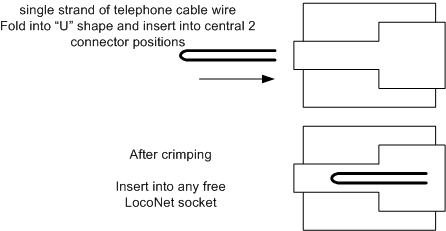- With a DCS100 or DB150, only one wire is driven; but a throttle shorts the two together.
- With a Zephyr, they are connected together through a small resistor
In most LocoNet set-ups, these two signals end up joined together. This is normal, and beneficial. For example the various plug-in throttles, DS54 units and LocoBuffers all join these two signals. However in some LocoNet systems this doesn’t happen. If you own a Zephyr system, and have very few LocoNet plug-in devices, this could be an issue. If you have add-on LocoNet devices that do not appear to be working correctly, it could be that the LocoNet signal is connected to the wrong wire. If you have a LocoShuttle connected to a Zephyr and it always reports “Fail no loco” when trying to acquire a loco, or a DTM30 which won’t control points properly – this could be the problem. But it is easily resolved!
By far the easiest solution is to insert a “shorting plug” into any spare LocoNet socket. This is simply assembled by crimping a single strand of LocoNet telephone cable to join connectors 3 and 4 of the 6 connector plug:

If you have the connectors and tools to make LocoNet cables, these will be easy to make. Alternatively CML Electronics can supply them.


